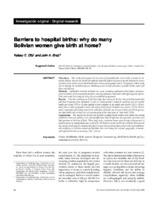Barriers to hospital births: why do many Bolivian women give birth at home?
| dc.contributor.author | Otis, Kelsey E | es_ES |
| dc.contributor.author | Brett, John A | es_ES |
| dc.date.accessioned | 2015 | |
| dc.date.available | 2015 | |
| dc.date.issued | 2008 | es_ES |
| dc.identifier.citation | Otis, Kelsey E,Brett, John A (2008) Barriers to hospital births: why do many Bolivian women give birth at home?. Rev Panam Salud Publica;24(1) 46-53,jul. 2008. Retrieved from http://www.scielosp.org/scielo.php?script=sci_arttext&pid=S1020-49892008000700006 | pt_BR |
| dc.identifier.uri | http://www.scielosp.org/scielo.php?script=sci_arttext&pid=S1020-49892008000700006 | es_ES |
| dc.identifier.uri | https://iris.paho.org/handle/10665.2/9963 | |
| dc.format.extent | tab | es_ES |
| dc.relation.ispartofseries | Rev Panam Salud Publica;24(1),jul. 2008 | es_ES |
| dc.subject | Home Childbirth | es_ES |
| dc.subject | Birth centers, hospital | es_ES |
| dc.subject | Humanizing Child Birth | es_ES |
| dc.subject | Health Policy | en_US |
| dc.subject | Maternal Mortality | es_ES |
| dc.subject | Bolivia | es_ES |
| dc.subject | Parto domiciliario | es_ES |
| dc.subject | Centros independientes de asistencia al embarazo y al parto | es_ES |
| dc.subject | Parto humanizado | es_ES |
| dc.subject | Política de Salud | es_ES |
| dc.subject | Mortalidad Materna | es_ES |
| dc.subject | Bolivia | es_ES |
| dc.subject | Parto Domiciliar | es_ES |
| dc.subject | Hospitais | es_ES |
| dc.subject | Bolívia | es_ES |
| dc.subject | Satisfação do Paciente | pt_BR |
| dc.title | Barriers to hospital births: why do many Bolivian women give birth at home? | pt_BR |
| dc.type | Journal articles | en_US |
| dc.rights.holder | Pan American Health Organization | en_US |
| dc.description.notes | OBJECTIVES: This study investigated the low rates of hospital/health center births recorded in Yapacaní, Bolivia, that persist despite the national maternal-infant insurance program designed to ensure equitable access to free center-based health care services for pregnant women. The purpose of this study was to identify the multilevel factors inhibiting access to and utilization of public health centers for labor and delivery. METHODS: Qualitative research methods were used, including participant observation, semistructured interviews of 62 community members, and key informant interviews with eight regional experts. Data were coded and analyzed using the grounded theory approach. RESULTS: From the semistructured interview data, five reasons for the low rate of institutional births and their frequency were identified: (1) fear or embarrassment related to receiving care at a public health care center (37 percent); (2) poor quality of care available at the health care centers (22 percent); (3) distance from or other geographic issues preventing timely travel to health care services (21 percent); (4) economic constraints preventing travel to or utilization of health care services (14 percent); and (5) the perception that health care services are not necessary due to the experience of "easy birth" (6 percent). CONCLUSIONS: The reasons for the low rate of births in public health centers exist within the context of deficient resources, politics, and cultural differences that all influence the experience of women and their partners at the time of birth. These large scale, contextual issues must be taken into account to improve access to quality health care services for all Bolivian women at the time of birth. Resources at the national level must be carefully targeted to ensure that governmental services will successfully instill confidence in Bolivian women and facilitate their overcoming the cultural, geographic, economic, and logistical barriers...(AU) | en_US |
| dc.description.notes | OBJETIVOS: Se investigó la baja tasa de partos en hospitales y centros de salud de Yapacaní, Bolivia, que persiste a pesar del programa nacional de seguro materno-infantil diseñado para garantizar el acceso equitativo a centros gratuitos de atención sanitaria para embarazadas. El objetivo de este estudio fue identificar los factores que a diversos niveles inhiben el acceso a centros públicos de salud para partos y su utilización. MÉTODOS: Se emplearon métodos cualitativos, entre ellos la observación participante, entrevistas semiestructuradas a 62 miembros de la comunidad y entrevistas a informantes clave con ocho expertos regionales. Los datos se codificaron y analizaron mediante el enfoque de teoría fundamentada. RESULTADOS: A partir de las entrevistas semiestructuradas se identificaron cinco razones para la baja tasa de partos institucionales y se establecieron sus frecuencias: 1) miedo o vergüenza a atenderse en un centro público de salud (37 por ciento); 2) baja calidad de la atención en los centros de salud (22 por ciento); 3) lejanía u otras barreras geográficas que impedían llegar oportunamente a los centros de salud (21 por ciento); 4) limitaciones económicas que impedían hacer el viaje o utilizar los servicios (14 por ciento); y 5) la percepción de que la atención sanitaria no era necesaria debido a la experiencia de "partos fáciles" (6 por ciento). CONCLUSIONES: Las razones de la baja tasa de partos observada en los centros públicos de salud estudiados se insertan en un contexto de escasos recursos, políticas deficientes y diferencias culturales que influyen en la experiencia de las mujeres y sus parejas en el momento del parto. Para mejorar el acceso a una atención sanitaria de calidad para todas las mujeres bolivianas en el momento del parto se deben tomar en cuenta estos problemas generalizados y contextuales. A nivel nacional, los recursos deben asignarse con cuidado para garantizar que los servicios gubernamentales logren...(AU) | es_ES |
Files in this item
This item appears in the following Collection(s)
-
Pan American Journal of Public Health
Revista Panamericana de Salud Pública




